Verdict
Like a can of Ronseal, the Tangent does exactly what it says on the tin. The TV functionality is brilliantly realised and it sounds great doing it even if it doesn’t do much else.
Pros
- Excellent HDMI implementation with decent sound quality
- Well made
- Very keenly priced
Cons
- Very limited extra functionality
- No volume indicator
-
HDMI ARCConnect the Ampster TV II straight to your TV -
Power2 x 50W amplification -
BluetoothStream audio over Bluetooth
Introduction
Tangent Audio has done a fine job in recent years of delivering affordable hi-fi products that manage to offer useful functionality and decent performance while undercutting most rivals.
The Ampster family of compact separates is designed to fulfil a variety of roles, either as standalone devices or used in groups of products. The Ampster TVII is a standalone device and is a twist on the existing Ampster II integrated amp.
As the name suggests, it’s designed to work with your TV (in fact, as I’ll cover, it’s pretty much only designed to do this) and if you have a flatscreen that’s lacking in a bit of sonic oomph, it could be exactly what you need. Does it deliver on the premise?
Availability
The Ampster TVII has a UK retail price of £199. The company does have distribution in North America and Canada but it’s not been possible to ascertain the price in US dollars but it’s likely to be similarly competitive. Tangent also sells into Australia but the TV II does not seem to have made it over to retail channels there at the time of writing (Jan 2024).
It is possible to buy integrated amplifiers from other companies at a similar sort of price. Finding one that has the same connectivity as the Tangent is rather more challenging though.
Companies like Yamaha and Cambridge Audio make more conventional options with a selection of analogue inputs but you’ll need to spend at least £100 more for something with an HDMI ARC connection in the form of the WiiM Amp. It’s only fair to point out that the WiiM can do rather more than the Tangent can which needs to be taken into account.
Design
- Metal chassis
- Input indicators
- Buetooth aerial
The Ampster TV II shares its casework with the rest of the family. This is a 195mm wide and 194mm deep metal chassis available in black, black or black. You can reasonably argue that it’s not the most exciting looking device going but it’s very well bolted together for the asking price. The paint finish is absolutely consistent and there’s no unwanted panel gaps or the like.
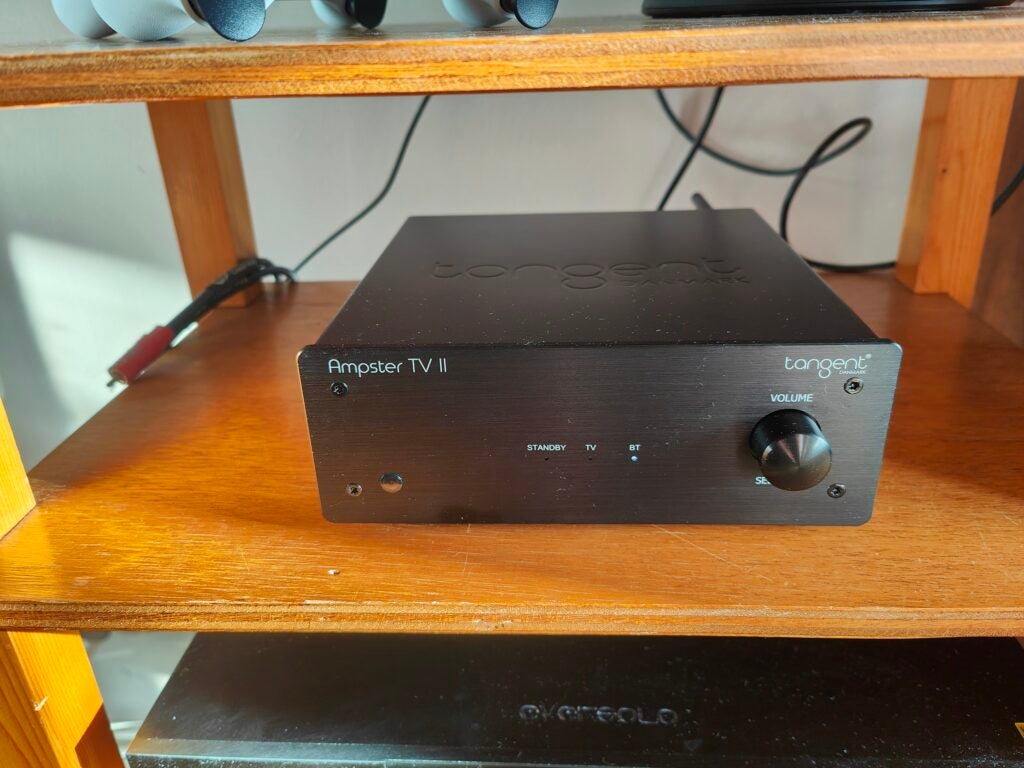
Around the front, you’ll find small LEDs that show the selected input and a volume knob. This is slightly unusual in that it is a rotary encoder type (that is to say, it has not start and finish point) but has no means of showing the level on the unit itself. This is a slight annoyance but, in the case of the TV II, it’s less of an issue than it might be on some other members of the range due to how its inputs work.
At the back is a large and slightly ungainly Bluetooth aerial and a pair of usefully stout speaker terminals. Considering the very competitive price, the Tangent is assembled and finished to a very decent standard.
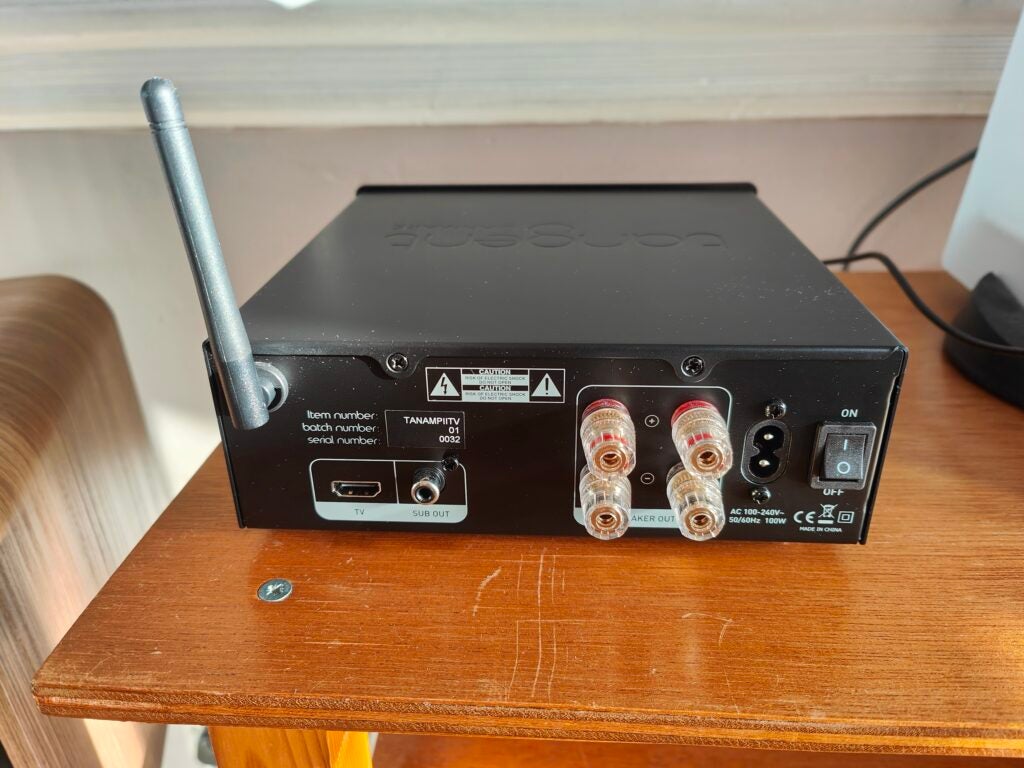
Features
- 50 watt internal amplifier
- HDMI ARC connection
- Apt-X HD Bluetooth
The Ampster TV II shares an amplifier stage with the existing Ampster II and that’s no bad thing. It’s a class D unit and power is quoted at 50 watts into four ohms (meaning you’ll get a bit less than that into an 8 ohm speaker). It’s not the sort of wattage that will level buildings but it should be enough to drive most similarly priced speakers without complaining. There is also a single subwoofer out in case you want to run sub/sat style speakers or simply give yourself a bit more low end welly.
While the Ampster II has a selection of analogue and digital inputs, the TV II is rather more specialised. The sole physical input on the unit is an HDMI ARC connection, designed to receive audio from the matching output on a TV. The good news is that this connection is really well implemented.
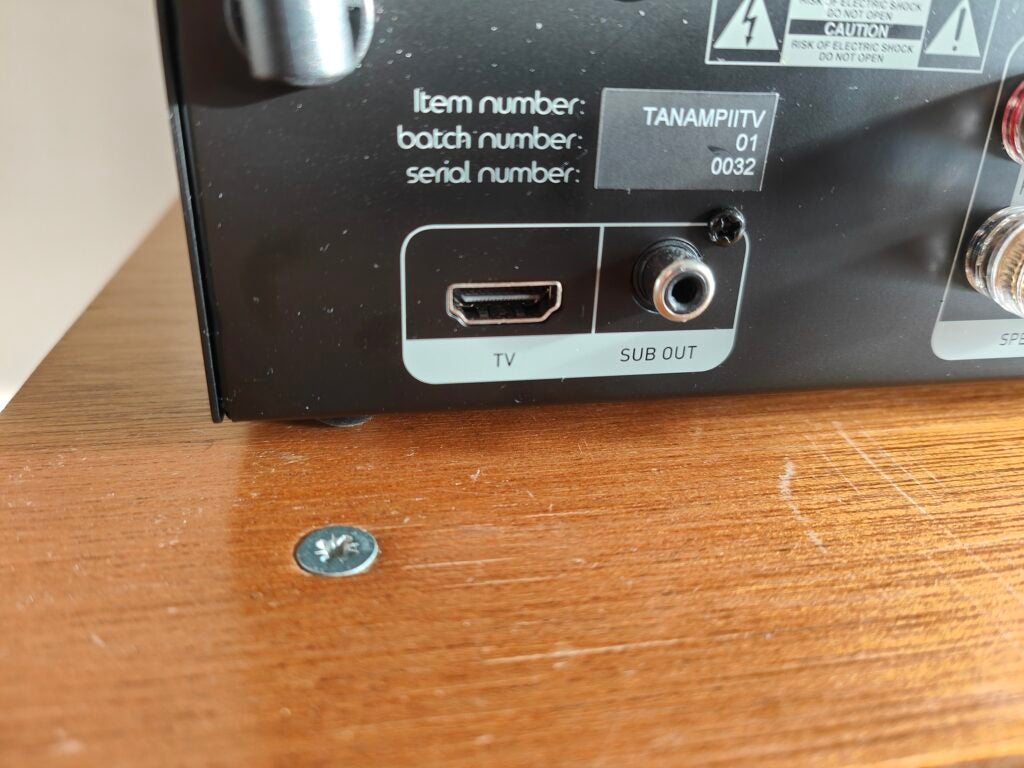
Turn the TV on and the Tangent responds instantly and is outputting audio seconds later. The volume control of the TV assumes control of the Tangent (it does come with its own IR handset too) and, this means that the lack of indicator on the TV II itself is less important because it always syncs to the TV level.
When you’ve finished, turn the TV off and the Tangent powers down at the same time. I’ve tested devices with HDMI ARC that cost more than ten times as much as the Tangent does where the connection doesn’t work as well as this one has.
Where things get a little more unusual though is that, in terms of physical connections, that’s it. The only other means of sending audio to the Tangent is via Bluetooth. This is a v5.0 base with aptX HD support which is respectable for Android devices but there’s no AAC capability for iOS users.
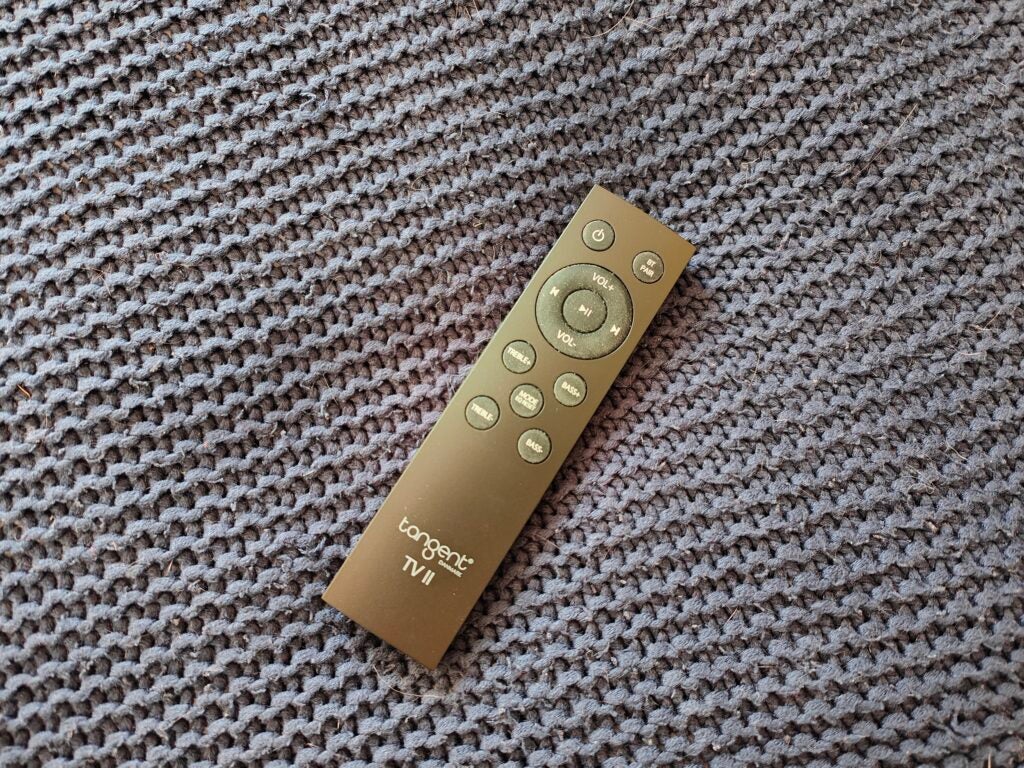
Where almost any other amplifier you can think of can be connected to some other source equipment, the Tangent offers no scope to use it outside of these two inputs, which means the amount of upgrade potential here is effectively non-existent. This can be partially bypassed by using your TV as a media hub for audio as well (which a number of smart TVs do rather well) but it does limit your options somewhat.
What’s even more unusual is that on some sites, the TV II can be found being offered as a bundle with other Tangent products… when there’s no immediately obvious way of connecting them together.
Sound Quality
- Clear dialogue
- Respectable Bluetooth sound
As the Tangent is very focused indeed towards use with a TV, it’s pretty good news that it sounds very good used in this manner. As noted, the HDMI connection has been utterly stable in use and the result is a seamless extension of the TV itself, which is handy if members of your household are less invested in sound quality than you are.
Connected to a pair of Q Acoustics 5020 standmount speakers; a design that is more expensive than might usually be the case to partner with the Tangent but are about the right size and sensitivity, the Tangent gives a very good account of itself.
Using the TV II to deliver the sound for a few episodes of Reacher shows that it gets an awful lot right. Dialogue is clear and easy to follow, even when events on screen are hectic and the soundstage it creates never feels like the sound is happening on either side of the screen; an area where systems of this nature can sometimes struggle next to a soundbar running directly underneath.
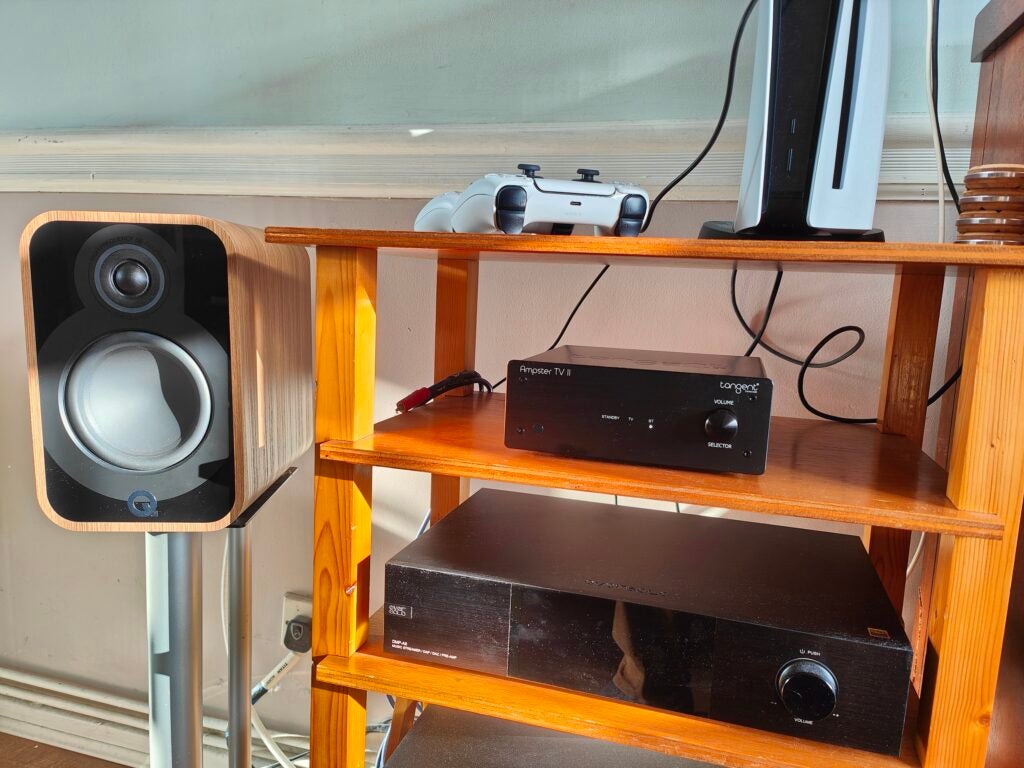
This is partnered with an ability to push information out from the screen to give you a greater sense of scale and space. It’s a different sort of immersion to the Atmos implementation on affordable soundbars but it’s effective, nevertheless.
What the Tangent also does very well is avoid hardening up when you listen loud. If you really push it to antisocial levels, it’ll begin to lose a little of its composure but even fairly hefty built in TV speakers will have thrown in the towel before that happens. This makes listening to the Tangent for extended periods more relaxing than listening to most integrated options, even when you aren’t necessarily looking for more output.
The absolute level of bass extension is going to depend on the speakers you choose to use with it but in almost all cases, you are going to experience more bass weight than from most TV speakers and there’s that sub output to bolster things further too.
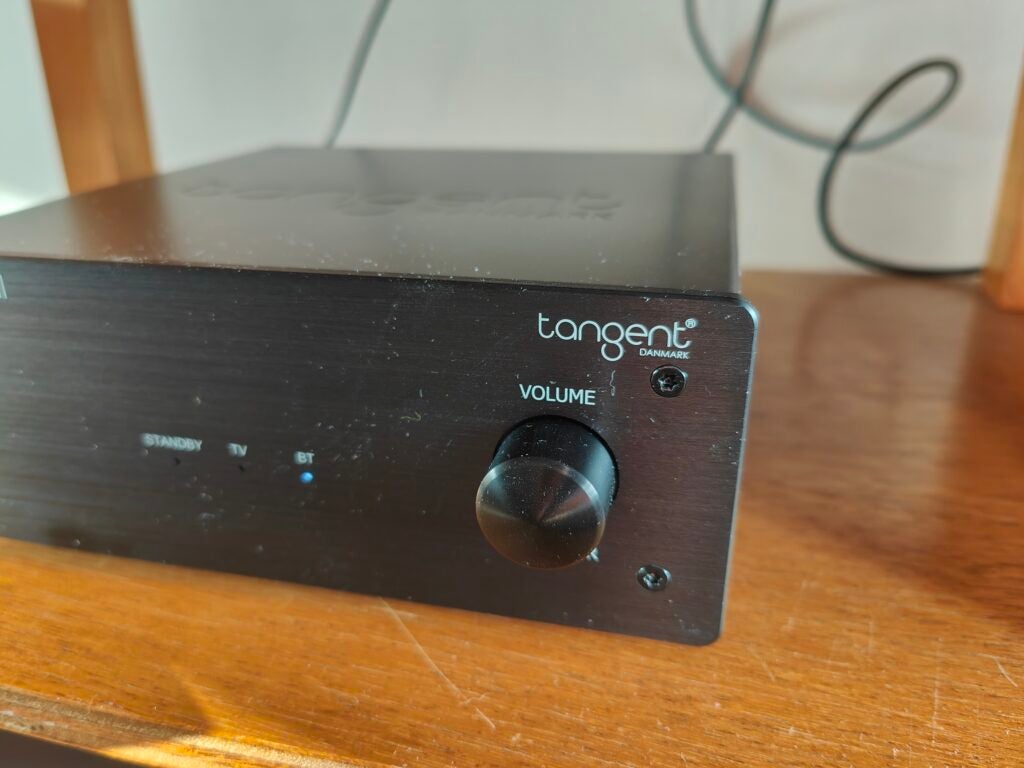
The Bluetooth performance is respectable but not quite so accomplished. Used via an Oppo Find X5 which has aptX HD, the performance is respectable but nothing to get truly excited about. Listening to Peter Gabriel’s i/o on Qobuz (which has a high-resolution version of this already outstanding recording), the result is perfectly listenable but there’s no huge leap forward over listening to the same album on Spotify; where even some very affordable digital sources will make more show of these differences. There’s also the more prosaic limitation that notifications and other unwanted distractions will make their way to the Tangent while your phone is paired to it.
On a whim, I installed the Spotify app on the TV and tried that as a source and the result was both listenable and arguably nicer to control than it is staring at a phone all the time. If you are already using your TV as a hub for all your media, the Tangent will integrate rather well with this use case but, where most other amps at the price could have something like a WiiM Mini connected to them to give you more streaming options, the complete absence of other connections on the Tangent rather rules this out.
Latest deals
Should you buy it?
Telly friendly
If you have a flatscreen that sounds a bit, well, flat and also have a pair of unused speakers knocking about, the Tangent is an extremely cost effective way of connecting the two together. It does so while sounding very good at the same time
Limited connections
If you have other equipment you want to make use of, the TV II doesn’t give you any option to make use of them. This is a brilliant way of boosting your TV sound… but not much else.
Final Thoughts
The Tangent is a rather niche bit of kit in that it does one (and a bit) thing, but it does do that thing very well. This is an extremely cost-effective way of boosting the sound of a smart screen, with excellent integration and more than respectable performance. If you need it for its intended purpose, it’s impossible to do better for less.
How we test
We test every system we review thoroughly over an extended period of time. We use industry standard tests to compare features properly. We’ll always tell you what we find. We never, ever, accept money to review a product.
Find out more about how we test in our ethics policy.
Tested with real world use
FAQs
The Ampster TV II is only meant to be used with a TV.
Verdict
Like a can of Ronseal, the Tangent does exactly what it says on the tin. The TV functionality is brilliantly realised and it sounds great doing it even if it doesn’t do much else.
Pros
- Excellent HDMI implementation with decent sound quality
- Well made
- Very keenly priced
Cons
- Very limited extra functionality
- No volume indicator
-
HDMI ARCConnect the Ampster TV II straight to your TV -
Power2 x 50W amplification -
BluetoothStream audio over Bluetooth
Introduction
Tangent Audio has done a fine job in recent years of delivering affordable hi-fi products that manage to offer useful functionality and decent performance while undercutting most rivals.
The Ampster family of compact separates is designed to fulfil a variety of roles, either as standalone devices or used in groups of products. The Ampster TVII is a standalone device and is a twist on the existing Ampster II integrated amp.
As the name suggests, it’s designed to work with your TV (in fact, as I’ll cover, it’s pretty much only designed to do this) and if you have a flatscreen that’s lacking in a bit of sonic oomph, it could be exactly what you need. Does it deliver on the premise?
Availability
The Ampster TVII has a UK retail price of £199. The company does have distribution in North America and Canada but it’s not been possible to ascertain the price in US dollars but it’s likely to be similarly competitive. Tangent also sells into Australia but the TV II does not seem to have made it over to retail channels there at the time of writing (Jan 2024).
It is possible to buy integrated amplifiers from other companies at a similar sort of price. Finding one that has the same connectivity as the Tangent is rather more challenging though.
Companies like Yamaha and Cambridge Audio make more conventional options with a selection of analogue inputs but you’ll need to spend at least £100 more for something with an HDMI ARC connection in the form of the WiiM Amp. It’s only fair to point out that the WiiM can do rather more than the Tangent can which needs to be taken into account.
Design
- Metal chassis
- Input indicators
- Buetooth aerial
The Ampster TV II shares its casework with the rest of the family. This is a 195mm wide and 194mm deep metal chassis available in black, black or black. You can reasonably argue that it’s not the most exciting looking device going but it’s very well bolted together for the asking price. The paint finish is absolutely consistent and there’s no unwanted panel gaps or the like.

Around the front, you’ll find small LEDs that show the selected input and a volume knob. This is slightly unusual in that it is a rotary encoder type (that is to say, it has not start and finish point) but has no means of showing the level on the unit itself. This is a slight annoyance but, in the case of the TV II, it’s less of an issue than it might be on some other members of the range due to how its inputs work.
At the back is a large and slightly ungainly Bluetooth aerial and a pair of usefully stout speaker terminals. Considering the very competitive price, the Tangent is assembled and finished to a very decent standard.

Features
- 50 watt internal amplifier
- HDMI ARC connection
- Apt-X HD Bluetooth
The Ampster TV II shares an amplifier stage with the existing Ampster II and that’s no bad thing. It’s a class D unit and power is quoted at 50 watts into four ohms (meaning you’ll get a bit less than that into an 8 ohm speaker). It’s not the sort of wattage that will level buildings but it should be enough to drive most similarly priced speakers without complaining. There is also a single subwoofer out in case you want to run sub/sat style speakers or simply give yourself a bit more low end welly.
While the Ampster II has a selection of analogue and digital inputs, the TV II is rather more specialised. The sole physical input on the unit is an HDMI ARC connection, designed to receive audio from the matching output on a TV. The good news is that this connection is really well implemented.

Turn the TV on and the Tangent responds instantly and is outputting audio seconds later. The volume control of the TV assumes control of the Tangent (it does come with its own IR handset too) and, this means that the lack of indicator on the TV II itself is less important because it always syncs to the TV level.
When you’ve finished, turn the TV off and the Tangent powers down at the same time. I’ve tested devices with HDMI ARC that cost more than ten times as much as the Tangent does where the connection doesn’t work as well as this one has.
Where things get a little more unusual though is that, in terms of physical connections, that’s it. The only other means of sending audio to the Tangent is via Bluetooth. This is a v5.0 base with aptX HD support which is respectable for Android devices but there’s no AAC capability for iOS users.

Where almost any other amplifier you can think of can be connected to some other source equipment, the Tangent offers no scope to use it outside of these two inputs, which means the amount of upgrade potential here is effectively non-existent. This can be partially bypassed by using your TV as a media hub for audio as well (which a number of smart TVs do rather well) but it does limit your options somewhat.
What’s even more unusual is that on some sites, the TV II can be found being offered as a bundle with other Tangent products… when there’s no immediately obvious way of connecting them together.
Sound Quality
- Clear dialogue
- Respectable Bluetooth sound
As the Tangent is very focused indeed towards use with a TV, it’s pretty good news that it sounds very good used in this manner. As noted, the HDMI connection has been utterly stable in use and the result is a seamless extension of the TV itself, which is handy if members of your household are less invested in sound quality than you are.
Connected to a pair of Q Acoustics 5020 standmount speakers; a design that is more expensive than might usually be the case to partner with the Tangent but are about the right size and sensitivity, the Tangent gives a very good account of itself.
Using the TV II to deliver the sound for a few episodes of Reacher shows that it gets an awful lot right. Dialogue is clear and easy to follow, even when events on screen are hectic and the soundstage it creates never feels like the sound is happening on either side of the screen; an area where systems of this nature can sometimes struggle next to a soundbar running directly underneath.

This is partnered with an ability to push information out from the screen to give you a greater sense of scale and space. It’s a different sort of immersion to the Atmos implementation on affordable soundbars but it’s effective, nevertheless.
What the Tangent also does very well is avoid hardening up when you listen loud. If you really push it to antisocial levels, it’ll begin to lose a little of its composure but even fairly hefty built in TV speakers will have thrown in the towel before that happens. This makes listening to the Tangent for extended periods more relaxing than listening to most integrated options, even when you aren’t necessarily looking for more output.
The absolute level of bass extension is going to depend on the speakers you choose to use with it but in almost all cases, you are going to experience more bass weight than from most TV speakers and there’s that sub output to bolster things further too.

The Bluetooth performance is respectable but not quite so accomplished. Used via an Oppo Find X5 which has aptX HD, the performance is respectable but nothing to get truly excited about. Listening to Peter Gabriel’s i/o on Qobuz (which has a high-resolution version of this already outstanding recording), the result is perfectly listenable but there’s no huge leap forward over listening to the same album on Spotify; where even some very affordable digital sources will make more show of these differences. There’s also the more prosaic limitation that notifications and other unwanted distractions will make their way to the Tangent while your phone is paired to it.
On a whim, I installed the Spotify app on the TV and tried that as a source and the result was both listenable and arguably nicer to control than it is staring at a phone all the time. If you are already using your TV as a hub for all your media, the Tangent will integrate rather well with this use case but, where most other amps at the price could have something like a WiiM Mini connected to them to give you more streaming options, the complete absence of other connections on the Tangent rather rules this out.
Latest deals
Should you buy it?
Telly friendly
If you have a flatscreen that sounds a bit, well, flat and also have a pair of unused speakers knocking about, the Tangent is an extremely cost effective way of connecting the two together. It does so while sounding very good at the same time
Limited connections
If you have other equipment you want to make use of, the TV II doesn’t give you any option to make use of them. This is a brilliant way of boosting your TV sound… but not much else.
Final Thoughts
The Tangent is a rather niche bit of kit in that it does one (and a bit) thing, but it does do that thing very well. This is an extremely cost-effective way of boosting the sound of a smart screen, with excellent integration and more than respectable performance. If you need it for its intended purpose, it’s impossible to do better for less.
How we test
We test every system we review thoroughly over an extended period of time. We use industry standard tests to compare features properly. We’ll always tell you what we find. We never, ever, accept money to review a product.
Find out more about how we test in our ethics policy.
Tested with real world use
FAQs
The Ampster TV II is only meant to be used with a TV.

























